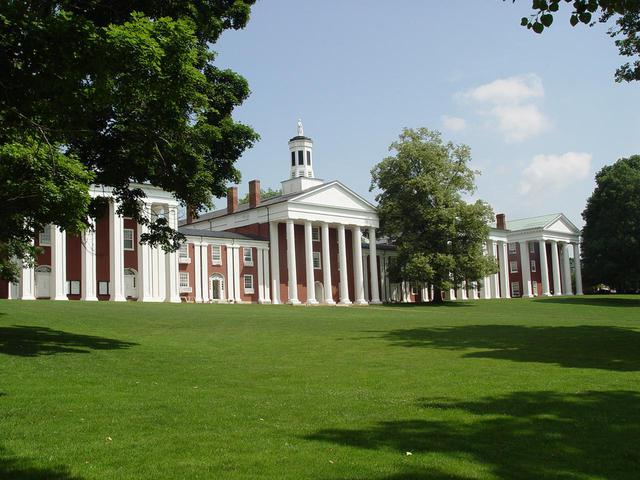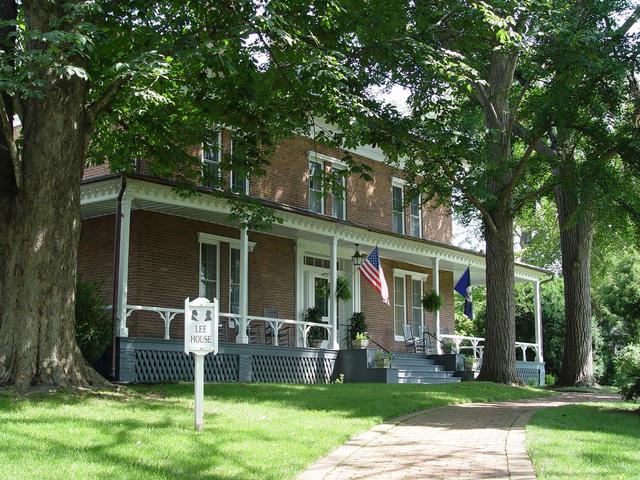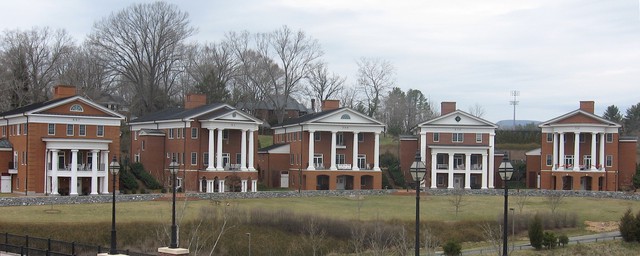Introduction
On a crisp fall afternoon in Virginia, students walk up the grassy slope to Washington and Lee’s colonnade, rows of white columns that define the face of the campus’s red brick buildings. The students walk in the shadows of the columns and climb the worn steps of Payne Hall. Just inside their classroom is a bronze plaque commemorating the space where General Robert E. Lee took his oath of office as president of the school in 1865. The open windows frame more students passing along the back campus. Some enter Leyburn Library, a wide complex of concrete and brick. Others open the doors to the Great Hall of the Science Center; vaulted, sky-lit ceilings expose balconies for each of the floors above, where more students move to and from completely modern classrooms and laboratories.
As these students cross Washington and Lee University’s picturesque campus, they see its balance of the old and the new—traditions and changes. Founded in 1749, the university boasts a long and rich history. The school won critical support in 1796 when George Washington donated $20,000 to its endowment. (Washington’s gift was the largest ever made to a private American school at the time, and the sum continues to pay a portion of every student’s tuition.) The school was known as Washington College at the end of the Civil War, when Robert E. Lee assumed its presidency. Lee led the college through far-reaching changes until his death in 1870. Washington and Lee students cherish Lee for his educational reforms: joining the college with a local law school, instituting classes in business and economics, creating the first college-level journalism program, and establishing the seeds of the student-governed Honor System. Those century-old innovations are now traditions that make Washington and Lee the fine liberal arts institution it is today. The university maintains these traditions and follows Lee’s example, always initiating change. The last decade has witnessed additions to the curriculum, complete revitalization of the fraternity system, and construction of new facilities for the fine arts, athletics, and the sciences. A new fitness center opened in Fall 2002, along with the newly renovated journalism school, and the new John W. Elrod University Commons opened in Fall 2003. The year 2006 saw the inaugural season of Wilson Hall, the new music and art facility. The renovation of Wilson Field, the stadium for football, lacrosse, and track and field, was completed in 2008, finishing the Richard L. Duchossois Athletic Complex.
Students at Washington and Lee call their school “W&L,” and their love for W&L is as loyal as their love for Lee. One former student admits:
I called home crying a few times during my freshman year because I was so grateful to my parents for giving me the opportunity to come to W&L.
National surveys routinely rank W&L students among the happiest in the country. When naming what makes them happy, every student generation names the same strong traditions: a small student body of 1,770 that is truly a community, intimate classes averaging around sixteen students, a faculty dedicated to students and to teaching, and an Honor System that creates a society of trust where no student will lie, cheat, or steal. The small town of Lexington, Virginia forms the backdrop for all of this student bliss.
Although only 7,000 residents live in Lexington year-round, students from Washington and Lee and its neighbor, the Virginia Military Institute, add substantially to the town’s true population. (The two schools add much to the town through their cultural and athletic programs as well.) One politics major notes:
The scenic, safe surroundings have allowed me to make W&L a home away from home, to enjoy the college experience without the worries and distractions of a big school or a big city.
W&L students become active citizens of Lexington as “big brothers” or “big sisters” to local youths, as coaches for Little League teams, as members of church congregations, and as participants in outreach groups such as Habitat for Humanity and the Nabors Service League. Although all W&L students call Lexington “home,” they journey from all corners of the United States to get there. Only eighteen percent of undergraduates hail from Virginia. Other well-represented states include Florida, Georgia, Maryland, New Jersey, New York, Pennsylvania, and Texas. It surprises many to learn that the student body includes nearly twice as many from California as from Kentucky. W&L truly has a national student body to match its national reputation. An intensified effort to recruit international students has resulted in attracting young men and women of nearly fifty citizenships.
Washington and Lee’s first-year residence halls are clustered on the edge of campus. With a renovation of the University’s historic Colonnade slated to begin in 2009, Baker Hall, a former residence hall for first year students, has been turned into offices and classrooms. So students now live in Davis and Gilliam Halls and in nearby Gaines Hall as well as Graham-Lees, which is across the street. An arched breezeway passes through Graham-Lees; on the left, a marble step between two columns is clearly worn more than the rest. Superstition holds that freshmen must walk up this step, between the columns, or risk failing their first test. Millions of feet have kept that tradition.
Just next door to Graham-Lees dormitory is the Lee House. Robert E. Lee built this home when he was the president of the school, and presidents of Washington and Lee have lived there ever since. Freshman voices can be heard in the Lee House as they echo from the dormitories. A past president joked that, although he preferred classical music, he could not help becoming familiar with the musical tastes of each freshman class. That the president of the university lives so close to the freshman class demonstrates something wonderful about Washington and Lee: The person who runs the school shares the same block with those who are just learning the school’s nuances. There is a continuity from the top of the administration to the bottom of the student body, and this continuity permeates the entire university. There is a sense of familiarity and camaraderie. Washington and Lee students cherish this camaraderie and guard it closely long after they leave the quaint streets of Lexington.











